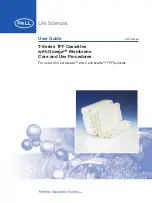
4. Check functionality of the directional valve
(207).
a. Confirm that the directional valve cable
is connected properly from HCM port 15
to the directional valve body (207) and
is not damaged. Inspect wiring inside
the cover of the directional valve. See
Electrical Schematics, page 105
b. During operation, the direction indicator
lights on the directional valve body (207)
should switch on based on the valve that
is open.
c. Turn on the motor and stall the pumps at
the lowest pressure setting (compensator
knob turned fully counter-clockwise).
The pump will travel in either the A or
B direction until the pressure setting is
reached.
d. Identify the solenoid that is operating
by viewing the direction indicator lights
on the cover of the directional valve
(207). Measure voltage across the
associated terminals to determine if
proper voltage is reaching the valve
(approximately 200 to 240 VAC). See
Electrical Schematics, page 105
, and
the table below, to identify the proper
terminals to measure across.
e. Trigger each proximity switch (211) with
the shaft of a screwdriver, confirming
each solenoid within the directional valve
(207) operates as described in table
below.
f.
If one or both sides are not operating
properly, according to the table, first
reconfirm wiring to directional valve
(207) per
Electrical Schematics, page 105
then replace directional valve (207).
For
For
For given
given
given
pump
pump
pump
movement
movement
movement
direction:
direction:
direction:
Pump
Pump
Pump driving
driving
driving
left
left
left (toward
(toward
(toward
park
park
park position)
position)
position)
Pump
Pump
Pump driving
driving
driving
right
right
right (away
(away
(away
from
from
from park
park
park
position)
position)
position)
ADM
indicates
Indicator light
on directional
valve cover
Left arrow,
labeled “b”
Right arrow,
labeled “a”
Last
proximity
switch
triggered
Right side
proximity
switch
Left side
proximity
switch
Terminals in
directional
valve
energized
Terminals
associated
with red and
orange wires
Terminals
associated
with black
and white
wires
NOTE:
NOTE:
NOTE: For diagnostic purposes, it is possible
to manually override the directional valve
by using a small screwdriver to depress the
button in the center of either directional
valve end cap. Depressing the button in the
right end cap should cause the pump to
travel to the right. Depressing the left button
should cause the pump to travel to the left.
5. If you have determined that the cause is
none of the previous possible causes, check
for a loose piston packing retaining bolt.
This causes the piston to contact the inner
face of the pump inlet flange before the
switching plate activates the proximity
switch. Shut down the unit and disassemble
the appropriate pump for repair.
Following
Following
Following step
step
step 1,
1,
1, if
if
if the
the
the proximity
proximity
proximity switch
switch
switch
indicating
indicating
indicating lights
lights
lights do
do
do not
not
not light:
light:
light:
6. Check for loose or faulty proximity
switch cable or connections. Confirm the
connections to the proximity switches are
tight and internally free from oil and other
contaminates.
7. Swap the cables to the proximity switches to
see if the problem follows the switch or is in
the cable. Replace either the failed switch
or the cable.
8. Replace the HCM. See
334946J
43
















































